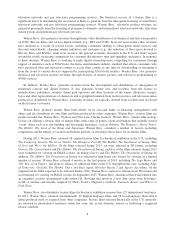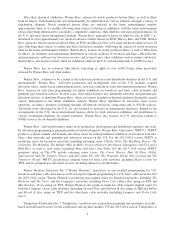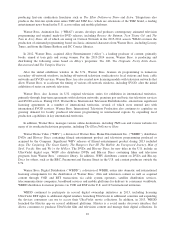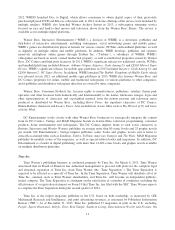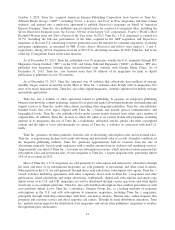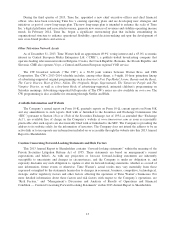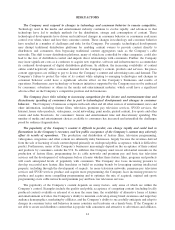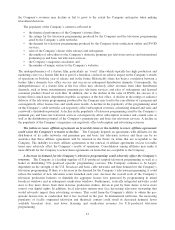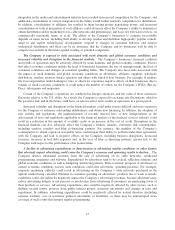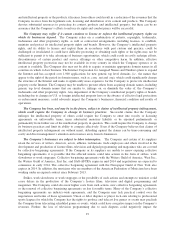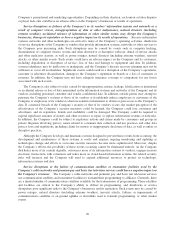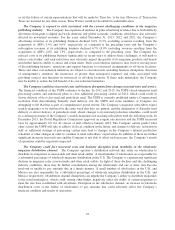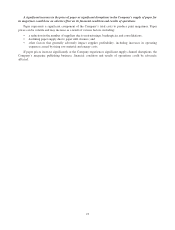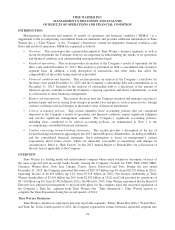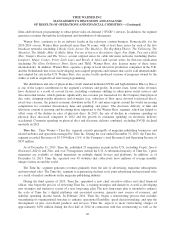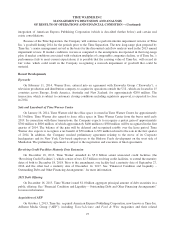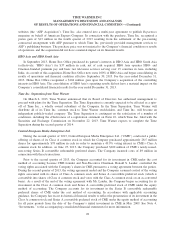Time Magazine 2013 Annual Report Download - page 34
Download and view the complete annual report
Please find page 34 of the 2013 Time Magazine annual report below. You can navigate through the pages in the report by either clicking on the pages listed below, or by using the keyword search tool below to find specific information within the annual report.Advertising sales and rates depend on audience size, and advertisers’ willingness to purchase advertising
from the Company and the price they are willing to pay may be adversely affected by a decline in audience
ratings, the number of unique visitors at the Company’s websites or in circulation or magazine readership for the
Company’s magazines. If audience levels decline significantly, the Company’s cable networks generally will be
required to provide additional advertising units to advertisers to reach agreed upon audience thresholds. This may
result in the Company’s cable networks having less inventory available to sell to advertisers or to use to promote
their own programming.
Time-shifted and on-demand viewing of programming and viewership on new platforms or devices that is
not being measured by the television ratings system could have a negative impact on ratings for the television
programming produced by the Company and the television programming aired by the Company’s cable
networks. For example, while the current television industry ratings standard measures live commercial viewing
plus three days of DVR and VOD playback, the growing viewership that occurs after three days is excluded from
these ratings. As a result, the inability to capture the total viewership of the Company’s programming could
adversely affect the Company’s ability to fully monetize its advertising inventory. Similarly, the advent of digital
magazines continues to shift how consumers interact with magazines and how the audience for digital magazines
is measured, which could negatively impact the rates advertisers are willing to pay for advertising in the
Company’s magazines.
The Company faces risks relating to doing business internationally that could adversely affect its
businesses and operating results. The Company’s businesses operate and serve customers worldwide, and the
Company is focused on expanding its international operations in key territories, including through acquisitions
and other strategic investments. The failure to achieve sufficient scale in these territories could negatively affect
the Company’s ability to compete in these territories. In addition, there are risks inherent in doing business
internationally, including:
• issues related to integrating and managing international operations;
• issues related to managing investments in companies organized or formed under the laws of foreign
countries;
• potentially adverse tax developments;
• lack of sufficient protection for intellectual property in some countries;
• territorial restrictions on content licensing;
• currency exchange restrictions, export controls and currency devaluation risks in some foreign countries,
including, but not limited to, Venezuela;
• the existence in some countries of statutory shareholder minority rights and restrictions on foreign direct
ownership;
• the existence of quotas;
• issues related to occupational safety and adherence to diverse local labor laws and regulations;
• political or social unrest;
• higher than anticipated costs of entry;
• the presence of corruption in certain countries;
• the absence of good diplomatic relations between the U.S. and certain countries; and
• the potential for government appropriation of the Company’s assets.
One or more of these factors could harm the Company’s international operations and its operating results.
Piracy of the Company’s content may decrease the revenues received from the exploitation of its content
and adversely affect its businesses and profitability. The piracy of the Company’s content, products and other
intellectual property poses significant challenges for the Company. Technological developments, such as the
proliferation of cloud-based storage and streaming, increased broadband Internet speed and penetration and
increased speed of mobile data transmission have made it easier to create, transmit, distribute and store high
quality unauthorized copies of content in unprotected digital formats, which has in turn encouraged the creation
of highly scalable businesses that facilitate, and in many instances financially benefit from, such piracy. Piracy is
particularly prevalent in many parts of the world that lack effective copyright and technical legal protections or
enforcement measures, and illegitimate operators based in these parts of the world can attract viewers from
anywhere in the world. The proliferation of unauthorized copies and piracy of the Company’s content, products
18


